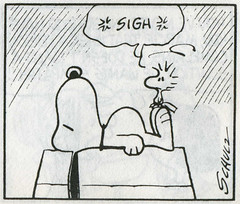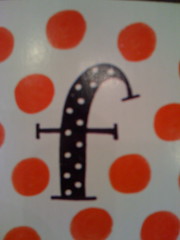We’ve looked at multiple ways to find your cliché gesture crutches . . . now what? How do we fix these little gestures that creep into our conversations and our manuscripts—eventually weighing down every single scene?
 We use crutches when we’re lame. Gesture crutches? They’re often a symptom of writing that’s limping along. Don’t let your writing limp! Make it run, jump, dance and sing!
We use crutches when we’re lame. Gesture crutches? They’re often a symptom of writing that’s limping along. Don’t let your writing limp! Make it run, jump, dance and sing!
Here are my top ten gesture crutches that I either write or see too often, and how I fix them. Note that the top ten will vary from person to person. I do not eliminate these words completely from my manuscript, but I try to make sure that I don’t use them too often or too close together, and when I do use them, they should be as fresh and unique as the scene can handle.
How do I tackle all this?
First, in a paper edit, I use one of the techniques from Wednesday, writing down the body parts/action in the margin, then reading those notes aloud for pattern and repetition. I make notes and adjustments based on that.
Later, I use a macro to “harvest” all the sentences containing those terms from my WIP. Rather than using find thousands of times, I go through that new document and make a note of a few things in the document:
- patterns (she smiled in joy, she smiled in gratitude, he frowned in disapproval, etc.)
- echos (“my heart kick starts” and “my pulse jumpstarts,” especially fairly close together)
- uses too close together
- uses that don’t make sense (could be the lack of context, but I made a note to check)
- uses that aren’t necessary
- uses that are awkward
- uses that could be fresher
- uses that are “bare” and could just be filler action tags: i.e. Jimmy frowned. “What do you mean?”—punch up, freshen, replace or cut. (Gasp! You could use a dialogue tag!)
On my first pass, I’m only marking the things I want to look at, unless inspiration for a rewrite strikes. Then I go back through and make the changes in the manuscript.
Fixing those crutches!
As I go through each set of sentences, I look at those notes and strategize how to make my changes. Here are some of the alternatives I’ve thought about for the following 10 gestures. Note that a lot of these strategies can work for all body language cues, so there’s a bit of repetition between the lists.
Nods
Characters who nod too much are liable to have their heads fall off, or at least sound like bobbleheads.
- Give a character (most likely just one) a unique, character-specific gesture—I used eyebrow-nods (it only happens 2-3 times).
- Change to just “agrees.”
- If the character is complying with a request, cut the nod altogether and just have them obey.
- If they were just nodding at something/someone, consider using gesturing, pointing, indicating with eyes, jerking head, tapping, etc.
- Convert some nods to dialogue: “Yes/yeah/sure.”
- Cut anything unnecessary.
- Punch up ones that remain, as much as you can in their context. A few examples of fresher nods to get your juices flowing:
- a single, decisive dip of the chin
- a yeah-sure-we’ll-see-about-that nod
- “The receptionist smiled and nodded in that way people do when they aren’t listening.” —Harlan Coben, No Second Chance
And remember: you don’t ever have to say a character nods her head/up and down/yes. They are all redundant. What else do you nod? How else do you nod? What else does a nod mean after a yes/no question?
Head shake
Again, we’re in danger of losing someone’s head due to stripped out cervical vertibrae. Just don’t.
- Convert to dialogue! From a flat-out “No” to a muttered “unbelievable,” dialogue can not only carry so much more impact than shaking one’s head, it can also make your meaning clearer without resorting to a pesky adverb.
- Use another gesture to portray the meaning: a sigh (if you haven’t already overused those!), a tongue-cluck, a wagging finger, etc.
- Use another verb for “shake”: wag, . . . . uhhhhh . . .
- Cut.
- If a lot of your head shakes are being used to convey the same message (other than no—maybe disbelief or disappointment), then take a little while to sit down and think about all the ways you can convey that nonverbally. Watch people, watch reality TV, watch well-acted movies, and see how those people look when they’re experiencing that emotion. Look for subtle and unique tells. Check out The Emotion Thesaurus, or this writers’ game, where you pick the body part first for more ideas.
- Try “disagrees,” “demurs” or other d words. I mean verbs of disagreement.
- If you have to have to have to keep it, punch it up! Maybe your character shakes his head like a dog getting out of the washtub, or like he’s afraid it’ll fall off, or like he’s wearing a neck brace.

Smiles
I swear, sometimes my characters sound like grinning idiots. Smile at this; smile at that. Save the smiles for when it counts, not just as a conversational smoother.
- Try other words, like beams or grins—but these are easy to overuse, too! I try to check these one after another.
- Give the character a particular type of smile. Maybe he smiles like a feral dog or a jack o’lantern, or a presidential candidate.
- Use subtext or dialogue to convey approval, gratitude, or other messages.
- Write it fresh! Give it a message, or use a simile to compare it to something (that isn’t a cliché). Some fresh smiles to get you thinking:
- “‘They’re all in there waiting for you,’ she said, flashing an I’m-glad-I’m-not-you smile.”—Angela Hunt, The Note, via Margie Lawson.
- From my WIP: “He orders two coffees with his I’m-so-charming-you-should-throw-in-something-for-free smile.”
- My favorite smile in all literature (can we say amplified?): “He smiled understandingly—much more than understandingly. It was one of those rare smiles with a quality of eternal reassurance in it, that you may come across four or five times in life. It faced—or seemed to face—the whole external world for an instant, and then concentrated on you with an irresistible prejudice in your favor. It understood you just as far as you wanted to be understood, believed in you as you would like to believe in yourself, and assured you that it had precisely the impression of you that, at your best, you hoped to convey.” —F. Scott Fitzgerald, The Great Gatsby
Raised Eyebrows
One raised eyebrow. Two. Three. It doesn’t matter. The gesture can mean anything from surprise to disbelief to sarcasm. It’s too generic and overused to mean much of anything these days: a classic cliché.
- Think about the underlying emotion and find other gestures that might convey it more clearly, especially since “he raised his eyebrows in confusion” becomes not only a cliché but also telling. Watch people, watch reality TV, watch well-acted movies, and see how those people look when they’re experiencing that emotion. Look for subtle and unique tells. Check out The Emotion Thesaurus, or this writers’ game, where you pick the body part first for more ideas.
- Cut.
- Use dialogue to convey the response or emotion.
- Write it fresh! Use a unique verb, describe their movement in a unique way, or show the message you’re trying to send. A few of my quick, fresh eyebrows:
- His eyebrows jumped to meet his receding hairline.
- “Uh huh,” he said, his eyebrow propped up an inch.
- She raised her eyebrow, nailing him with that patented mother-knows-better-than-you look.
An exception to the rule: most of the time, you don’t have to eradicate these words, but I think I’ll be eliminating the majority of my plain eyebrow raises.

Glance
It’s like my characters can’t look at anything for very long. Focus, people! You do not have ADH—squirrel!
- Use another verb. Be careful not to overuse synonyms or use words so unusual that they call attention to themselves.
- If it’s the POV character, just show what s/he saw and skip the filter word.
- If the glance is less to see something and more to convey a particular message, spell out the message in a fresh or funny way.
- Ooor use dialogue for that fresh, funny message.
- Write it fresh!
Furrowed brow (or eyebrows drawing together)
In my latest manuscript, the only time I mentioned “brows” was when they were furrowed. Which makes mine furrowed, too.
- Use a simile. Lots of things are wrinkly: pugs, my laundry, septuagenarians. Note: are stormclouds overused in this context?
- It seems like this expression rarely occurs in isolation. Focus on another part of the face or the body language. As always, this is best with a gesture or body part that’s specific and unique to the character.
- Watch either of these in the POV character. Both can sound like an external visual instead of the character describing his/her own conscious movements.
- Write it fresh! Some fresh eyebrows & brows to get you rolling:
- She looks like Our Lady of Perpetual Solemnity.
- His eyebrows pull together in knit two, purl two ribbing. (Want to get uberjargony? Say “k2p2 rib.”)
- The gray caterpillars above his eyes lean in for an intimate moment.
Eyes widen/narrow/light up
I make my characters’ expressions while writing. . . . I probably look like I have crazy eyes!
- Find another body part or part of the expression to highlight. I’m searching for a good way to write the feeling of your scalp tightening when you’re surprised.
- Use a simile. Can her eyes light up like a firework or narrow like a camera lens?
- Go for dialogue instead. In Mr. & Mrs. Smith, Brad Pitt’s character tells Angelina Jolie’s that when he first saw her, she looked like Christmas morning. A kid’s eyes lighting up on Christmas morning would have been a cliché; instead the writers used a metaphor an narrowly avoided the tired phrase.
- My favorite way to write it fresh: Find a character-specific situation to describe in a simile. What would make her eyes narrow? A lying ex? A too-good to be true sale? A delinquent teen? What makes his eyes light up? Hot girls? A challenging math puzzle? The latest FPS video game?
Laugh
I’ve written whole conversations where the characters just take turns laughing. But laughing is one of those things: if the character laughs, the reader doesn’t have to.
- Is it really that funny? “LOL” really means “I found that amusing” these days. Don’t overuse laughing with your characters that way.
- Is a response necessary? Sometimes you can cut the laugh altogether.
- Use dialogue, and if you’re already using dialogue, drop the laughter.
- Consider a synonym for laugh, but most chortles and guffaws draw attention to themselves.
- Describe the laugh to make it pop. Write it fresh!:
- A suuuure-you-can laugh.
- Her laughter was bright and thin and , like the sound of cheap jingle bells you buy one year—and the next find inexplicably silent.

Sigh
Okay, I’m being sarcastic about the other gestures, but I really did once write a scene where a character decided not to sigh, thinking everyone else was doing enough moody exhaling for them all.
- Especially watch for clichés like “a sigh of relief.” Write it fresher!
- If they’re not absolutely necessary, delete!
- Look at the underlying emotion. How else might it be manifest? Vocal tone? Shoulders, fists,
- Look at another narrative mode. Would it be more powerful to describe the reason for the sigh in thought, or better yet, dialogue?
- If you must use several sighs, you might consider finding a way to punch them up systematically. In Paranormalcy by Kiersten White, one of her characters is introduced early on as speaking a “professional sigher.”
- Kiersten White goes further than that, describing those sighs with the message they send:
- “This was more of a sympathetic, I know what it’s like to be a human wrapped up in all this non-sense, but if we didn’t do it, who would? kind of a sigh” (12).
- “Raquel gave me her best why is it always me that has to deal with these things sigh (one I was well familiar with at this point), then patted me on the shoulder” (20).
- “She gave a can I just start shocking him into submission now sort of sigh” (25).
Gaze/Eyes
Aside from the eyes widening, narrowing or lighting up, they tend to do a lot of other things to convey meaning. Although I would NEVER recommend cutting all the eyes (ouch!), watch out for using too many eyes in one scene. Even alternating them with gaze might not work if that’s overused, too.
- Track the usage: are those gazes/eyes, meeting, avoiding, lowering, falling, etc. too much or in too close proximity?
- Alternate gaze/eyes—within reason! Don’t describe a gaze with the color of the eyes, etc. (A blue gaze? No.)
- Try an alternative noun, as long as they’re not overused, too (many of these are on my watch list!): stare, (fixed) look, scrutiny, inspection, regard.
- Or, if it’s a verb, try an alternate verb (again, many of these are also on my watch list): stare, look (fixedly), gape, goggle, eye, study, scrutinize, ogle, eyeball, observe, view, contemplate, regard, survey, consider, watch, check out, size up.
- Use a nickname for the eyes, or bring out a character description or personality with them. Perhaps a flirtatious character bats his baby blues.
- Maybe being more general might help, using the word face or expression.
- As always, look at the underlying message. How else can you portray that in body language? Hands touching/not touching/pulling away? Physical proximity? Turning toward or away?
- Consider whether the message might carry more power as a thought or dialogue, if appropriate.
In conclusion
Is this hard work? YES! Is it worth it? We can—well, actually, we probably can’t cite examples of less-than-engaging writing in published books: unless they’re book-throwing bad, we tend to gloss over this boring body language just like we do a lot of other unstellar examples.
I can’t help but believe this level of care, attention and effort pays off in your writing.
Final note: Let me say again that I don’t feel compelled to change every use of everything. I left my share of nods, smiles, and eyebrows in my latest manuscript. If we didn’t use these body parts and actions, our writing probably wouldn’t feel realistic. But now I feel my writing is more engaging because I’ve eliminated the superfluous, meaningless, confusing and repetitive.
What do you think? How do you fix these gesture crutches? Is this worth it?
Photo credits
crutches on orange background—Christian Guthier; “smile”—Andy Hay;
crutches through window—Amy van der Hiel; sigh—Lucy/squacco
 Last week, I gave a class at the LDStorymakers Conference on gesture crutches. You can find my presentation here, but today I’m sharing the resources I cited in class!
Last week, I gave a class at the LDStorymakers Conference on gesture crutches. You can find my presentation here, but today I’m sharing the resources I cited in class!
 We use crutches when we’re lame. Gesture crutches? They’re often a symptom of writing that’s limping along. Don’t let your writing limp! Make it run, jump, dance and sing!
We use crutches when we’re lame. Gesture crutches? They’re often a symptom of writing that’s limping along. Don’t let your writing limp! Make it run, jump, dance and sing!


 What are gesture crutches, and why should we avoid them? As
What are gesture crutches, and why should we avoid them? As  I also heartily recommend
I also heartily recommend  ).
).


